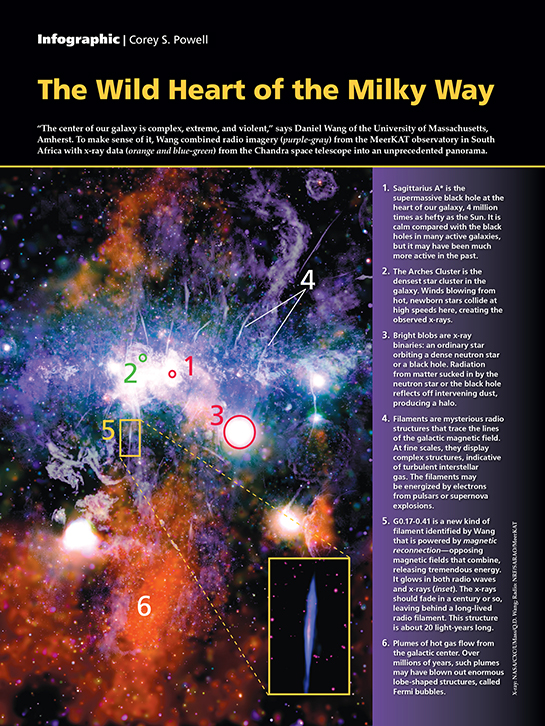
This Article From Issue
September-October 2021
Volume 109, Number 5
Page 272
“The center of our galaxy is complex, extreme, and violent,” says Daniel Wang of the University of Massachusetts, Amherst. To make sense of it, Wang combined radio imagery (purple-gray) from the MeerKAT observatory in South Africa with x-ray data (orange and blue-green) from the Chandra space telescope into an unprecedented panorama.

Image from X-ray: NASA / CXC / UMass / Q.D. Wang; Radio: NRF / SARAO / MeerKAT
Ad Right
- Sagittarius A* is the supermassive black hole at the heart of our galaxy, 4 million times as hefty as the Sun. It is calm compared with the black holes in many active galaxies, but it may have been much more active in the past.
- The Arches Cluster is the densest star cluster in the galaxy. Winds blowing from hot, newborn stars collide at high speeds here, creating the observed x-rays.
- Bright blobs are x-ray binaries: an ordinary star orbiting a dense neutron star or a black hole. Radiation from matter sucked in by the neutron star or the black hole reflects off intervening dust, producing a halo.
- Filaments are mysterious radio structures that trace the lines of the galactic magnetic field. At fine scales, they display complex structures, indicative of turbulent interstellar gas. The filaments may be energized by electrons from pulsars or supernova explosions.
- G0.17-0.41 is a new kind of filament identified by Wang that is powered by magnetic reconnection—opposing magnetic fields that combine, releasing tremendous energy. It glows in both radio waves and x-rays (inset). The x-rays should fade in a century or so, leaving behind a long-lived radio filament. This structure is about 20 light-years long.
- Plumes of hot gas flow from the galactic center. Over millions of years, such plumes may have blown out enormous lobe-shaped structures, called Fermi bubbles.

American Scientist Comments and Discussion
To discuss our articles or comment on them, please share them and tag American Scientist on social media platforms. Here are links to our profiles on Twitter, Facebook, and LinkedIn.
If we re-share your post, we will moderate comments/discussion following our comments policy.